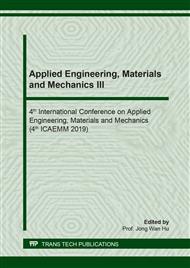[1]
G. Pitarresi, D. Tumino, A. Mancuso, Thermo-Mechanical Behaviour of Flax-Fibre Reinforced Epoxy Laminates for Industrial Applications, Mater. 8(11) (2015) 7371-7388.
DOI: 10.3390/ma8115384
Google Scholar
[2]
B. Barari, E. Omrani, A. Dorri Moghadam, P. L. Menezes, K. M. Pillai, P. K. Rohatgi, Mechanical, physical and tribological characterization of nano-cellulose fibers reinforced bio-epoxy composites: An attempt to fabricate and scale the Green, composite, Carbohydr. Polym. 147 (2016) 282-293.
DOI: 10.1016/j.carbpol.2016.03.097
Google Scholar
[3]
S. Chonsakorn, S. Srivorradatpaisan, R. Mongkholrattanasit, Effects of different extraction methods on some properties of water hyacinth fiber, J. Nat. Fibers, (2018) 1-11.
DOI: 10.1080/15440478.2018.1448316
Google Scholar
[4]
H. Abral et al., Mechanical properties of water hyacinth fibers – polyester composites before and after immersion in water, Mater. Des. 58 (2014) 125-129.
DOI: 10.1016/j.matdes.2014.01.043
Google Scholar
[5]
C. M. Vu, D. D. Nguyen, L. H. Sinh, T. D. Pham, L. T. Pham, H. J. Choi, environmentally benign green composites based on epoxy resin/bacterial cellulose reinforced glass fiber: Fabrication and mechanical characteristics, Polym. Test. 61 (2017) 150-161.
DOI: 10.1016/j.polymertesting.2017.05.013
Google Scholar
[6]
J.-W. Rhim, H.-M. Park, C.-S. Ha, Bio-nanocomposites for food packaging applications, Prog. Polym. Sci. 38(10-11) (2013) 1629-1652.
DOI: 10.1016/j.progpolymsci.2013.05.008
Google Scholar
[7]
T. Padmavanthi, S. Venkata Naidu, R. Rao, Studies on Mechanical Behavior of Surface Modified Sisal Fibre – Epoxy Composites, J. Reinf. Plast. Compos. 31(8) (2012) 519-532.
DOI: 10.1177/0731684412438954
Google Scholar
[8]
Z. Khan, B. F. Yousif, M. Islam, Fracture behaviour of bamboo fiber reinforced epoxy composites, Compos. Part B Eng. 116 (2017) 186-199.
DOI: 10.1016/j.compositesb.2017.02.015
Google Scholar
[9]
N. Sgriccia, M. C. Hawley, M. Misra, Characterization of natural fiber surfaces and natural fiber composites, Compos. Part A Appl. Sci. Manuf. 39(10) (2008) 1632-1637.
DOI: 10.1016/j.compositesa.2008.07.007
Google Scholar
[10]
N.F. Ramirez, Y.S. Hernandez, J.C. de Leon, S.R.V. Garcia, L.D. Lvova, L.G. Gonzalez, Composites from water hyacinth (Eichhornea crassipe) and polyester resin, Fibers Polym. 16(1) (2015) 196-200.
DOI: 10.1007/s12221-015-0196-5
Google Scholar
[11]
M. Sharma, I. M. Rao, J. Bijwe, Influence of orientation of long fibers in carbon fiber–polyetherimide composites on mechanical and tribological properties, Wear, 267(5-8) (2009) 839-845.
DOI: 10.1016/j.wear.2009.01.015
Google Scholar


